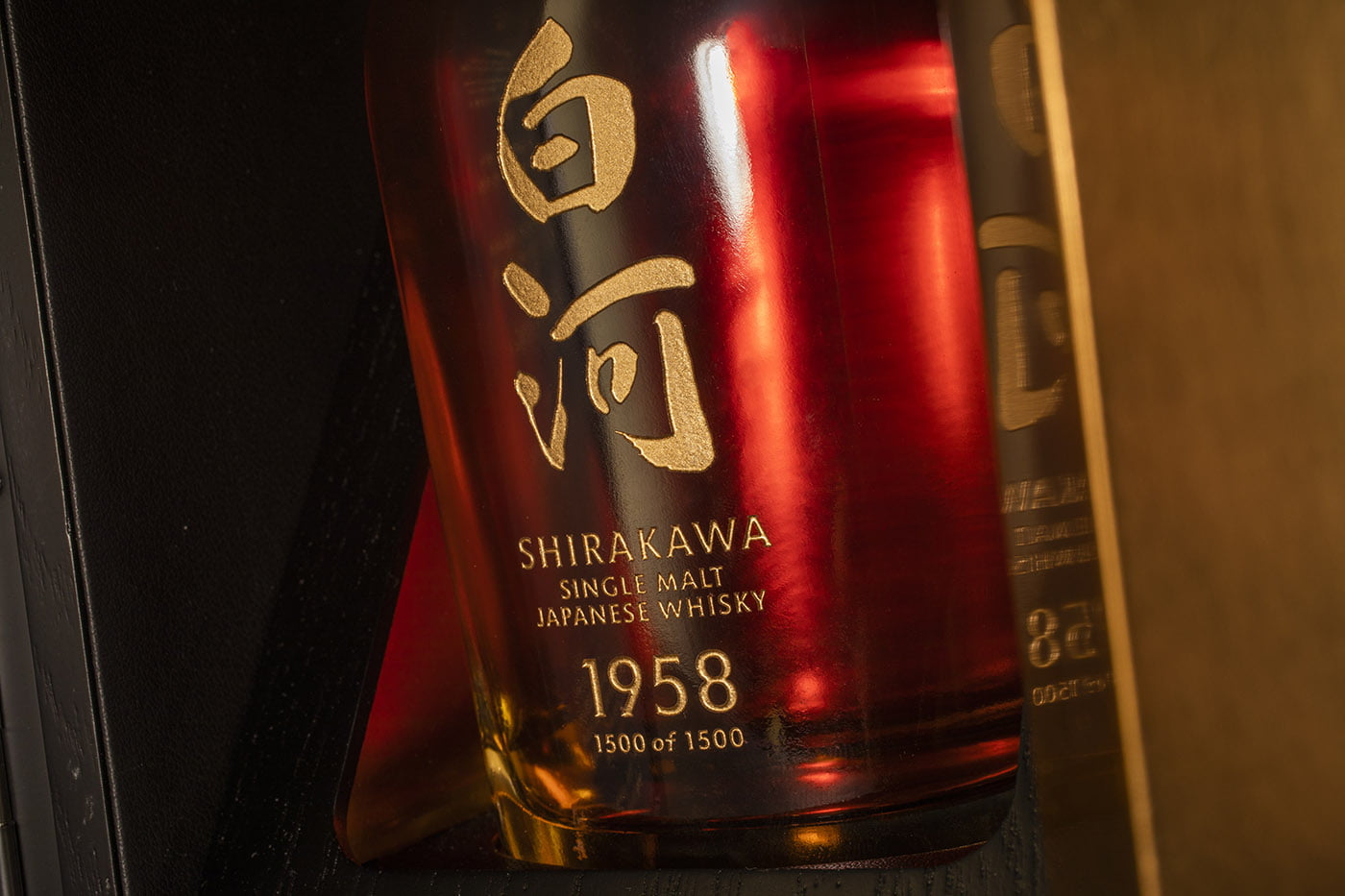This extremely rare and highly limited whisky is launching in Japan — very soon
The World’s Rarest Japanese Whisky, Shirakawa 1958 Single Malt Japanese Whisky from Takara Shuzo Co.,Ltd was released on the 13th September 2022. It is targeted to launch in Japan in May 2023, and will be exclusively available directly from Tomatin Distillery and from select specialist whisky retailers.
Shirakawa 1958 is a single malt whisky from the lost Japanese distillery, Shirakawa, which was located 200km North of Tokyo, Japan. The whisky produced was rumoured to be exquisite, but destined only for blending and never to be captured as a single malt until now, with a collaboration between Tomatin Distillery and Takara Shuzo. This remarkable and incredibly rare expression will be the only official single malt bottling from Shirakawa Distillery; limited to 1,500 bottles globally and is the earliest single vintage Japanese whisky ever bottled.
“There are no known examples of Japanese Whisky claiming to be from a Single Vintage that predate Shirakawa 1958,” confirms Stefan van Eycken, the pre-eminent authority on the world of Japanese whisky and distilling. “Even though Shirakawa Distillery was one of the pioneers of malt whisky making in Japan, the liquid was never officially available as a single malt. This limited 1,500-bottle release will see the Japanese Whisky category — one of the most sought-after categories of spirits in the world — continue to grow from strength to strength”.
Stephen Bremner, Managing Director of Tomatin Distillery Co. Ltd. had become intrigued by parent company Takara Shuzo’s history of malt whisky production in Japan, and why so little was known about this aspect of the company’s history. Determined to uncover more, he pieced together anecdotal information from previous employees about whisky production and searched for long-lost documents that might shed some light on Shirakawa’s single malt Japanese whisky-making past.
The final remaining parcel was identified in Takara Shuzo’s Kurokabegura in 2019. The liquid had been distilled in 1958, aged in cask, then transferred to ceramic jars at the distillery. When Shirakawa closed, it was put into stainless steel tanks at Takara Shuzo’s factory in Kyushu where it lay untouched until now.
Here’s all you need to know about this unique and fascinating spirit.
The Distillery:
Where was Shirakawa Distillery and what stands there today?
Shirakawa Distillery was located in the city of Shirakawa in the Fukushima prefecture, roughly 200km north of Tokyo. In 2011 Takara Shuzo donated the land to the Fukushima prefecture to build emergency housing to accommodate people displaced by the 2011 Tohoku earthquake and tsunami.
What is Shirakawa’s provenance?
Shirakawa Distillery was established in 1939 by DaikokuBudoshu (a subsidiary of Takara Shuzo at the time) who would go on to build Karuizawa Distillery in 1956. Following the 1947 Antimonopoly Act, Takara Shuzo was forced to divest itself of DaikokuBudoshu. Keen to retain the Shirakawa Distillery, Takara purchased this asset from DaikokuBudoshu.
What else did the distillery produce and what else was it known for?
During its lifetime, it produced several forms of wine and spirits, particularly shochu. From 1951 to 1969, the distillery produced malt whisky, uninterrupted, which was used in the Takara Shuzo’s “King” and “Ideal” blended whisky brands.
When did Shirakawa stop distilling?
Shirakawa distillery first produced malt whisky in 1951 and — though a former employee has a vague recollection of production in 1983 and 1985 — on paper, malt whisky production at Shirakawa was discontinued in 1969. However, the distillery continued to produce other spirits after 1969, particularly shochu. We can’t say for certain when this ended; though by the mid-1990s, the distillery had started suffering from old age. Many of the buildings were decrepit and the equipment was old. By the early 2000s, the Shirakawa Factory was on its last legs and merely used as a bottling facility.
Why did Takara close the distillery in 2003 when Single Malt Japanese Whisky was becoming more popular?
Although Japanese whisky was beginning to gain international recognition and acclaim in the early 2000s, exports were almost negligible and consumption within Japan, where shochu had overtaken whisky in terms of market share in 1985, continued to decline. As such, whisky production across Japan was greatly scaled back at this time. However, malt whisky production at Shirakawa Distillery had ended long before this. During the 1970s and 80s, Takara Shuzo’s focus shifted from whisky to shochu and, although they continued to produce King Whisky, the recipe contained an increasing proportion of Scotch Malt Whiskies. The purchase of Tomatin Distillery in 1986 meant that the company no longer depended on malt whisky produced at Shirakawa. By the early 2000s Shirakawa, which was suffering from old age, was only used as a bottling hall; and in 2003, it was closed and the buildings, demolished.
Are there plans to open the Shirakawa Distillery again?
There are no plans to reopen the Shirakawa Distillery. Shirakawa Distillery was closed and its buildings demolished in 2003. In 2011 Takara Shuzo donated the land to the Fukushima prefecture to build emergency housing to accommodate people displaced by the 2011 Tohoku earthquake and tsunami.
Why have we never heard of this distillery before?
Even though Shirakawa distillery was one of the pioneers of malt whisky making in Japan, it was never officially available as a single malt. That category didn’t take off in Japan until the mid-80s, and by that time, Takara Shuzo’s focus lay elsewhere. The vast majority of the malt whisky produced at Shirakawa was used in Takara Shuzo’s “King Whisky.” If it wasn’t for the discovery of this parcel of whisky from Shirakawa in 2019, it would have remained an unknown lost distillery.
The Production:
How was malt whisky made at Shirakawa Distillery?
Although much of the Shirakawa story remains unknown, a production summary book from March 1990 provides a wealth of information on malt whisky production at Shirakawa which falls into three periods.The first period covers the years from 1951 to 1957. During that period, domestic barley was used and mashing was done in one go, with the water temperature between 55-65°C and then gradually increased to 80°C. The fermentation time was 4 days at 25°C and the distillation took place in two stainless steel pot stills heated with steam coils. The middle cut averaged 65%abv. The spirit was then reduced to just under 60%abv and filled into 350-litre casks made domestically from Tohoku and Hokkaido mizunara (Japanese oak).
The second period covers the years from 1958 to 1966 and the switch to copper pot stills would have resulted in a significant improvement in the quality of the spirit produced. During this period, the distillery kept working mainly with domestic malted barley, supplemented with the occasional load of imported malted barley. For the mashing they switched to two waters — the first at 62°C for three hours, the second at 65°C for 2 hours. And sometimes, most likely during the summer months, a short third-water phase, 15 minutes at 80°C, to keep the wort free from bacterial contamination. The fermentation was increased to five days, and as mentioned, the distillation took place in twin copper pots. Spirit was collected at 73.1-57.1%abv, quite a wide middle cut, making for an average still strength of 66.7%. Domestic casks of the type mentioned above remained the go-to for maturation, but American white oak casks (presumably virgin-oak casks) and “imported casks” (it’s unclear what exactly that meant) were also used from time to time.
The third period covers the last two years of the 60s, 1968-1969. During this time, the distillery used mainly imported malted barley. For the mashing, they had settled on three phases: the first at 60°C for three hours, the second at 65°C for two hours and the third at 80°C for 15 minutes. The fermentation remained five days and the middle cut was adjusted upward, with spirit collected at 74.6-60.8%abv, averaging 68.5%. There are no indications as to what cask types were used during this period.
Was the barley peated or unpeated?
Unpeated.
What type of yeast was used?
Distillery records indicate that from 1951 to 1966 one of the company’s wine yeasts was used. From 1967 to 1969 a distiller’s yeast from Scotland was used.
What equipment was used?
According to the two former employees, the malt whisky production kit included a stainless steel mash tun with a capacity of 18,000L, five or six stainless fermenters of the same capacity, which were also used for shochu making; and two copper pot stills with a 9,000L capacity each. Rare photos of the stills, including the inside of one of the stills, show two fairly squat pots of almost identical shape — the spirit still slightly more squat than the wash still — with straight heads and descending lyne-arms, slightly more pronounced on the wash still than the spirit still, and both indirect-heated.
Was the production at Shirakawa similar to that in Scotland?
The first few years of whisky production at Shirakawa would have produced a very different product than a Scottish distillery. However, the installation of copper pot stills in 1958 and the switch to distillers yeast in 1967, amongst other changes, led to a comment in company records from the third period of whisky making which states “we arrived at the level of Scotch-type malt”.
The Whisky:
How many bottles were released in 2022?
There were just 1,500 bottles. They will be the only official ottling of Shirakawa Single Malt, ever.
Why now? Where has the whisky been all this time?
Shirakawa Distillery was closed and demolished in 2003. Prior to this, we don’t know when, the whisky was transferred from cask, first to large ceramic pots and then to stainless steel tanks. During the closure of the distillery, these tanks were moved to Takara Shuzo’s Takanabe Factory (renamed as Kurokabegura in 2004) in Kyushu. As time passed, fewer and fewer people in the company were even aware the whisky existed and it was slowly forgotten about. The whisky was only rediscovered in 2019.
How was the whisky discovered?
Stephen Bremner, Managing Director at the Tomatin Distillery Co. Ltd., had become intrigued by parent company Takara Shuzo’s history of malt whisky production in Japan. Very little was known about this aspect of the company’s history but undeterred, he kept asking questions and knocking on doors, hopeful that some liquid trace remained somewhere within the company. This led, in 2019, to the discovery of this parcel of Shirakawa Single Malt Japanese Whisky.
Who can verify the finding?
Takara Shuzo, the owner of Shirakawa Distillery from 1947 until its closure in 2003, and the bottler of this vintage, have both provided information from internal documentation to verify the finding.Two leading research institutions have also analyzed the whisky.
Why was the whisky moved from cask to large ceramic pots and then to stainless steel containers?
Though we can’t say for certain when this decision was made or what the motivation was behind it, we believe that there were two driving factors. First, we know that by the time the distillery was closed in 2003, the buildings were in poor condition. This would have included the whisky warehouses. As such, the move to ceramic pots and laterally, to stainless steel containers (both of which Shirakawa would have had in house as they are commonly used in shochu production), may have been to reduce the risk of losses due to building damage. Another possibility is that the distillery wanted to avoid any further maturation losses. So removing the whisky from cask would have given Takara Shuzo time to decide how they wanted to use this stock.
When was the whisky removed from cask?
We do not know. Much like the whisky itself, many of the warehouse records from Shirakawa have been lost since the distillery was demolished and they remain undiscovered.
Where was the whisky stored once it came out of casks?
The whisky was initially moved to large ceramic pots and then filled into stainless steel containers. Up until at least January 31, 2002, the whisky remained at its Shirakawa home. After that, either in the course of 2002 or in 2003 when the distillery was mothballed, the liquid was moved to Takara Shuzo’s Takanabe Factory (renamed as Kurokabegura by the company in 2004) in Kyushu.
Would the whisky have been impacted by being stored in stainless steel vessels for so long?
No, stainless steel is completely inert in contact with alcohol and is an ideal material to be used in the construction of storage vessels.
What type of cask was the whisky originally matured in?
A production summary book from March 1990 shows that from 1958 — when this whisky was distilled — to 1966, the vast majority of casks used at Shirakawa were 350-litre in capacity and made domestically from Tohoku and Hokkaido mizunara (Japanese) oak. However, American white oak and “imported casks” were also used from time to time. Although it would be logical to assume that these imports began later in the period in discussion. Sensory analysis likewise points to the use of Mizunara oak in the Shirakawa 1958.
Have there ever been any other releases of Shirakawa Single Malt?
There has never been another official bottling of Shirakawa Single Malt.
Why have there been no official Shirakawa releases before now?
The sole purpose of producing malt whisky at Shirakawa distillery was to provide a supply of whisky for Takara Shuzo’s “King Whisky” blend. The first single malt Japanese whisky was released in 1975 and it was a decade before the category took off. By that time, Takara Shuzo’s focus lay elsewhere. The closest that Takara Shuzo came to releasing a single malt expression of Shirakawa was in the late 1980s, when they released a Pure Malt Shirakawa 12 Year Old which contained 80% Shirakawa from 1968 and 1969, with the remaining 20% being made up of two 12 Year Old Islay malts in equal measure.
Is there more stock of Shirakawa owned by Independent bottlers?
There is no evidence that Takara Shuzo sold any stock of Shirakawa to independent bottlers. Furthermore, the practice of distillers trading stock for blends which exists in Scotland and often provides bottlers with a source of stock, does not exist in Japan. So although we cannot say for certain that there is no stock owned by an independent bottler, it is highly unlikely.
What do you mean by “earliest known single vintage Japanese whisky?”
The Shirakawa 1958 is the earliest known single vintage Japanese whisky. This means that no other bottling of Japanese whisky has claimed to be from a single year predating 1958.
What about the Yamazaki 50-Year-Old releases from 2005 and 2007? They must use whisky that was distilled before 1958.
We are not making the claim that this is the earliest Japanese whisky to be distilled. Indeed, any whisky sold in Japan before 1960 would have contained whisky distilled before 1958. There are no known examples of Japanese whisky claiming to be from a single vintage that predates the Shirakawa 1958. With regards to the Yamazaki 50 Year Old releases from 2005 and 2007, whilst these contain whisky from before 1958, these have been bottled as age statements and do not make reference to the whisky been from a single vintage.
The sole purpose of producing malt whisky at Shirakawa distillery was to provide a supply of whisky for Takara Shuzo’s “King Whisky” blend. The first single malt Japanese whisky was released in 1975 and it was a decade before the category took off.
Stephen Bremner, Managing Director of Tomatin Distillery Co. Ltd.
Is this whisky chill filtered and caramel coloured?
No.
What is the ABV
49%
Is this whisky JSLMA compliant? Does it meet the definition of a Japanese Whisky laid out on the 12th of February 2021 by the Japan Spirits & Liqueurs Makers Association?
Yes. This whisky was made with malted barley and Japanese water, produced in Japan, had an alcohol content of less than 95% ABV at the time of distillation, was matured in wooden casks not exceeding 700L in capacity for a minimum of three years in Japan, and was bottled in Japan at a strength of at least 40% ABV.
Was this whisky made using Koji? In other words, is this barrel-aged shochu?
No. This is Single Malt Japanese Whisky made with only malted barley, water, and yeast. It is compliant with the standards for Japanese whisky established by the JSLMA in 2021.
Have any known whisky authorities tasted this whisky?
Stefan Van Eycken, author of Whisky Rising: The Definitive Guide to the Finest Whiskies and Distillers of Japan is the preeminent authority on Japanese whisky. He has sampled these whiskies and said: “Not only was this an amazing find, but its backstory is unlike any other whisky I’ve ever heard about… It’s a remarkable whisky which clearly has spent a long time in cask, but which is remarkably vibrant. It’s mature, and elegant with a waxy feel, sweet fruits, incense, and spices.”
Dave Broom, world whisky expert and author of over a dozen whisky books including The Way of Whisky: A Journey Around Japanese Whisky said:“Nose: Resinous, slight dry earth, dried citrus peels, a hint of wax. Aromatic. A drop of water makes it more vibrant and also shows clear maturity as well as a hint of incense. Exotic. The palate is expansive with a succulent texture, hints of fragrant grass. Fruits emerge in the middle. Nicely balanced and persistent on the finish. Layered, spiced, and dry. Water brings out ash from an incense burner, a satisfying mouthfeel and surprisingly perky acidity. The finish picks up that mint and makes it more camphor like. It was good to see such obvious cask-aged maturity present suggesting that first period was a lengthy one. Light oxidation has added to the overall quality without flattening aroma. “
Has any analysis been done on the whisky?
Yes, the whisky has been analyzed by two of the whisky industry’s leading independent scientific bodies.
Price and Investment:
How much is it?
It is sold at an RRP of £25,000
Why is it worth £25,000?
The discovery of this parcel of Shirakawa Single Malt Japanese Whisky is a momentous occasion in Japanese whisky history. This is the only official bottling from Shirakawa Distillery, one of the pioneers of malt whisky making in Japan, ever. Limited to just 1,500 bottles worldwide. In addition, it is the earliest known single vintage Japanese whisky. As a result, this is the rarest Japanese whisky ever released.
Are there any other examples of Single Malt Japanese Whisky where the age is not known?
Yes, the low production volumes of Single Malt Japanese Whisky from the late 1990s through to around 2010 have led to several NAS releases in order to satisfy consumer demand. Where the Shirakawa 1958 differ is that we are not trying to conceal the age of young whisky; sensory analysis suggests that thisis an incredibly well aged single malts.
Why is it so expensive?
In a nutshell, it is because Shirakawa Single Malt is the world’s rarest Japanese whisky.Here are the core reasons:
- In 1951 the distillery became one of the pioneers of malt whisky making in Japan, but production stopped in earnest in 1969.
- The distillery was demolished in 2003, so no more whisky can be produced.
- There will only ever be one official bottling of this whisky, limited to 1,500 bottles.
- The 1958 expression is the earliest known single vintage Japanese whisky.
Why is this so much more expensive than the current oldest Japanese single malt, Saburomaru 1960?
Saburomaru distillery is still in operation and continues to produce whisky so it does not have the “end game factor” that closed distilleries do.The 1960 was produced in a continuous still; so, although it is bottled as a single malt, it does not meet the same batch production criteria as Shirakawa.
Is this similar to any other closed Japanese distilleries?
There are some striking similarities between Shirakawa and Karuizawa:
- Both facilities were opened by DaikokuBudoshu.
- Both began producing malt whisky in the 1950s; Shirakawa in 1951 and Karuizawa in 1956.
- Both produced malt whisky for blends; Shirakawa was produced for “King” and Karuizawa for “Ocean”.
- Both distilleries have been demolished; Shirakawa in 2003 and Karuizawa in 2016.
However, there are some notable differences which make Shirakawa the rarest Japanese whisky ever released:
- Whilst Karuizawa produced malt whisky until 2000, production of malt whisky at Shirakawa stopped in earnest in 1969.
- When the remaining stock of Karuizawa was purchased by Number One Drinks in 2011 there was a total of 364 casks.
- The earliest vintage of Karuizawa ever bottled is from 1960. The Shirakawa 1958 predates this.
- How much will this go up in value?
It is impossible to know how any investment will perform. However, historical performance has shown that investment in Japanese whisky, particularly from closed distilleries, can provide incredible returns. Scotch Whisky 101’s Japanese 100 Index has grown 530.88% since 29/12/2014 and continues to deliver double digit annual growth. Of the 100 bottles in this Index, 86 are from closed distilleries. Shirakawa, as a closed distillery that will only ever release one official bottling, is the rarest Japanese whisky in the world.
Why is this being distributed by Tomatin; that is to say, why not by Takara themselves?
Tomatin Distillery Co. Ltd. are a subsidiary of Takara Shuzo. They have an extensive route to whisky buying audiences, globally.
Who is really behind this release? Takara or Tomatin?
The incredible discovery of this whisky and the development of these two Shirakawa bottlings is a collaboration between Takara Shuzo, the owner and bottler of the two parcels of stock, and Tomatin Distillery Co. Ltd., the global distributor of these whiskies. The team at Tomatin, led by Stephen Bremner, have decades of experience in the global whisky industry and have a detailed knowledge of the production, maturation and curation of exceptionally rare whiskies.Stephen identified that there might be a parcel of Shirakawa stored somewhere and it was his relentless drive, which helped find it and bring it to the market.
Who is the face of the product?
Stephen Bremner, Managing Director at the Tomatin Distillery Co. Ltd., is responsible for the discovery of this unique Shirakawa Single Malt Japanese Whisky and will be available for interviews. Scott Adamson, Global Brand Ambassador at the Tomatin Distillery Co. Ltd. will be available for tasting events.
Whisky Profile:
What is its Nose?
This aged single malt displays complex layers of waxy oak-driven aromas whilst retaining the vibrancy of a truly exceptional spirit. Sweet fruit and nut in the form of marzipan, candied pineapple and orange liqueur are to the fore, gradually making way for more organic notes of cut grass, honeysuckle and coconut. The seductive scent of exotic incense captures waves of spices, floral and woody aromas.
What is its Palate?
The balance of maturity and vibrancy continues well onto the palate. An almost effervescent apple and zingy lime curd are quickly balanced by soft marzipan and white chocolate. This mix of fruit and nut evolves into a tropical trail mix with a dusting of cinnamon and ginger.
What is its Finish?
In time, the fruits dissipate leaving a soft nuttiness, light spice and a touch of smoke.










